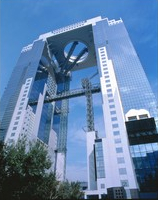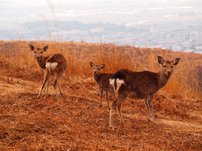
Optional Tours for accompanying persons:
You can apply for the optional short tours via online or on site at the travel desk.
Excursion
We are now planning for attractive excursion courses around Osaka. There will be Osaka, Himeji, Nara, and Kyoto courses. We look forward to seeing you at this program.
*Excursion participation fee is included in registration fee.
|
SUNDAY Oct 18 |
MONDAY Oct 19 |
TUESDAY Oct 20 |
WEDNESDAY Oct 21 |
|
|---|---|---|---|---|
| MORNING | ||||
| AFTERNOON |
Excursion 13:00 – 17:00 |
|||
| EVENING |
Welcome Reception 18:00 – 20:00 |
Exhibitor Reception 17:30 – 19:00 |
Conference Banquet 19:00 – |
Highlight of Osaka Course
● Osaka Castle
 Osaka Castle was a monumental fortification constructed, upon the order of Toyotomi Hideyoshi, to be the strongest and most beautiful castle in Japan. It is recorded that 30,000 to 40,000 people a day labored to build the castle, enclosed by stone walls 12 kilometers in length. The castle took three and a half years to complete. It was completely destroyed by Tokugawa Ieyasu after a war in 1615. He rebuilt the castle, but in 1665 it was struck by lightning and burned to the ground. Today Osaka Castle's five-story donjon, constructed of ferroconcrete after the original in 1931, towers 40 meters and affords an extensive view. A two-story tower, built in 1620, and other structures also remain. The donjon displays items relating to the Toyotomi family. Photo © Osaka Castle.
Osaka Castle was a monumental fortification constructed, upon the order of Toyotomi Hideyoshi, to be the strongest and most beautiful castle in Japan. It is recorded that 30,000 to 40,000 people a day labored to build the castle, enclosed by stone walls 12 kilometers in length. The castle took three and a half years to complete. It was completely destroyed by Tokugawa Ieyasu after a war in 1615. He rebuilt the castle, but in 1665 it was struck by lightning and burned to the ground. Today Osaka Castle's five-story donjon, constructed of ferroconcrete after the original in 1931, towers 40 meters and affords an extensive view. A two-story tower, built in 1620, and other structures also remain. The donjon displays items relating to the Toyotomi family. Photo © Osaka Castle.
● The Floating Garden Observatory
 The Floating Garden Observatory is a rooftop observation deck on the Umeda Sky Building affording a panoramic view of Osaka with Awajima Island and Kobe in the distance. The "floating garden" connects by a bridge construction method the two 40-story skyscrapers that make up the Umeda Sky Building. The Floating Garden, with spectacular views and filled with trees and flowers, is open to the public. In the basement of the building is the restaurant mall Takimi Koji, a recreation, through alleys and signboards, of the atmosphere of Osaka from the Taisho era to the early Showa era (about 1915 - 1935). Photo © The Floating Garden Observatory.
The Floating Garden Observatory is a rooftop observation deck on the Umeda Sky Building affording a panoramic view of Osaka with Awajima Island and Kobe in the distance. The "floating garden" connects by a bridge construction method the two 40-story skyscrapers that make up the Umeda Sky Building. The Floating Garden, with spectacular views and filled with trees and flowers, is open to the public. In the basement of the building is the restaurant mall Takimi Koji, a recreation, through alleys and signboards, of the atmosphere of Osaka from the Taisho era to the early Showa era (about 1915 - 1935). Photo © The Floating Garden Observatory.
● Shitennoji Temple
Built in 593, Shitennoji Temple is believed to be the oldest Buddhist temple in Japan and though it has been rebuilt many times in its long history, excavations have shown the current layout to be very true to its original design. The temple's great southern gate (Nandaimon), central gate (Chumon), pagoda, main hall (Kondoh) and lecture hall (Kodo) are constructed in a straight line, a design layout called "Shitennoji Cathedral Style." The temple houses six national treasures and many other items of cultural importance.
Highlight of Himeji Course
● Himeji Castle
 Registered on UNESCO'S World Heritage list in 1993, Himeji Castle — also known as the White Heron Castle — represents Japanese castle architecture at its highest, with almost all of the castle structure still intact from its original construction in the early 1600's. The nickname of White Heron Castle comes from the graceful appearance of the castle's white plaster walls. The castle grounds are divided into inner- and outer-walled zones, with gates built around maze-like spaces to confuse enemies, and a double moat for extra protection. The six-story donjon stands at the highest point in the inner-walled zone. Photo © Himeji Castle.
Registered on UNESCO'S World Heritage list in 1993, Himeji Castle — also known as the White Heron Castle — represents Japanese castle architecture at its highest, with almost all of the castle structure still intact from its original construction in the early 1600's. The nickname of White Heron Castle comes from the graceful appearance of the castle's white plaster walls. The castle grounds are divided into inner- and outer-walled zones, with gates built around maze-like spaces to confuse enemies, and a double moat for extra protection. The six-story donjon stands at the highest point in the inner-walled zone. Photo © Himeji Castle.
Highlight of Nara Couse
● Todaiji Temple
Todaiji Temple, completed in 752, houses one of the largest bronze statues in the world. The temple is approached through an imposing gate supported by eighteen 25-meter-high pillars. It was built in the eighth century. Blown down by a typhoon in 962, the gate was rebuilt in 1199. It is a National Treasure, as are two wooden images of the Deva kings in its exterior niches. The present Hall of the Great Buddha, dating from 1709, is the world's largest ancient wooden structure and a National Treasure. The Great Buddha, a National Treasure, was cast in bronze in eight sections over three years, being completed in 749. The 16.2-meter-high figure is seated on a huge bronze pedestal 20.7 meters in circumference.
● Nara Park
 Nara Park is otherwise known as "Deer Park" for the twelve hundred deer which inhabit it. These tame deer roam through groves of cedars, and oaks, andromedas and wisteria. They have been deified and are strictly protected as messengers of deities of the Kasuga Taisha Shrine. Nara Park dates from 1880. It was designated as a place noted for scenic beauty by the National Government in 1922. The 660-hectare park is dotted with various temples and shrines including Todaiji Temple, the Kofukuji Temple, and the Kasuga Taisha Shrine. Photo © Today's Nara Park.
Nara Park is otherwise known as "Deer Park" for the twelve hundred deer which inhabit it. These tame deer roam through groves of cedars, and oaks, andromedas and wisteria. They have been deified and are strictly protected as messengers of deities of the Kasuga Taisha Shrine. Nara Park dates from 1880. It was designated as a place noted for scenic beauty by the National Government in 1922. The 660-hectare park is dotted with various temples and shrines including Todaiji Temple, the Kofukuji Temple, and the Kasuga Taisha Shrine. Photo © Today's Nara Park.
Highlight of Kyoto Course
● Toji Temple
Toji Temple in Kyoto is site of the tallest pagoda in all Japan, a five-story structure that stands 57 meters high. The temple was established in 796, with the pagoda first built in 826. The pagoda was later destroyed by fires and has been rebuilt four times, most recently in 1644. The scene of the illuminated pagoda at night is one of the classic views of Kyoto. The temple also contains numerous rare Buddhist art treasures which have managed to survive the fires of history. The temple belongs to the mystic Shingon sect of Buddhism.
![[Logo] NTT FACILITIES](./img/ntt-f.png)
![[Logo] HITACHI Group](./img/hitachi.png)
![[Logo] DELTA ELECTRONICS](./img/delta.png)
![[Logo] ELTEK POWER](./img/eltek.png)
![[Logo] HUAWEI TECHNOLOGIES](./img/huawei.png)
![[Logo] ZTE](./img/zte.png)
![[Logo] DAIHEN](./img/daihen.png)
![[Logo] GE Critical Power](./img/ge.png)
![[Logo] Mitsubishi Electric](./img/mitsubishi.png)
![[Logo] Saft](./img/saft.png)
![[Logo] Vicor](./img/vicor.png)
![[Logo] SHODEN](./img/shoden.png)